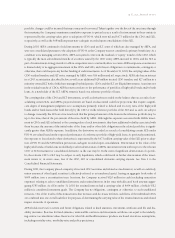American Express 2003 Annual Report Download - page 71
Download and view the complete annual report
Please find page 71 of the 2003 American Express annual report below. You can navigate through the pages in the report by either clicking on the pages listed below, or by using the keyword search tool below to find specific information within the annual report.
(p.69_axp_ financial review)
The negative effect on AEFA’s pretax earnings of a 10 percent decline in equity markets would be approximately $89 mil-
lion and $57 million based on assets under management, certificate and annuity business inforce, and index options as of
December 31, 2003 and 2002, respectively.
AEFA’s acquisition of Threadneedle resulted in balance sheet exposures to foreign exchange risk, which is managed pri-
marily by entering into agreements to buy and sell currencies on a spot or forward basis. At December 31, 2003, foreign
currency products with total notional amounts of approximately $777 million were outstanding. Based on the year-end
2003 foreign exchange positions, the effect on AEFA’s earnings and equity of a hypothetical 10 percent strengthening of the
U.S. dollar would be immaterial.
AEFA’s owned investment securities are, for the most part, held by its life insurance and investment certificate subsidiaries,
which primarily invest in long-term and intermediate-term fixed income securities to provide their clients with a compet-
itive rate of return on their investments while controlling risk. Investment in fixed income securities is designed to provide
AEFA with a targeted margin between the interest rate earned on investments and the interest rate credited to clients’
accounts. AEFA does not trade in securities to generate short-term profits for its own account.
AEFA’s Balance Sheet Management Committee and the Company’s ERMC regularly review models projecting various inter-
est rate scenarios and risk/return measures and their effect on the profitability of the Company. The committees’ objectives
are to structure their investment security portfolios based upon the type and behavior of the products in the liability
portfolios to achieve targeted levels of profitability within defined risk parameters and to meet contractual obligations.
Part of the committees’ strategies include the use of derivatives, such as interest rate caps, swaps and floors, for risk
management purposes.
AMERICAN EXPRESS BANK
Results of Operations
STATEMENTS OF OPERATIONS
Years Ended December 31, (Millions) 2003 2002 2001
Net revenues:
Interest income $575 $606 $ 698
Interest expense 226 246 396
Net interest income 349 360 302
Commissions and fees 238 215 203
Foreign exchange income and other revenues 214 170 144
Total net revenues 801 745 649
Expenses:
Human resources 271 236 247
Other operating expenses 279 244 255
Provisions for losses:
Ongoing 102 147 65
Restructuring related ——26
Total provisions for losses 102 147 91
Restructuring charges (2) (3) 70
Total expenses 650 624 663
Pretax income (loss) 151 121 (14)
Income tax provision (benefit) 49 41 (1)
Net income (loss) $102 $80$(13)
























